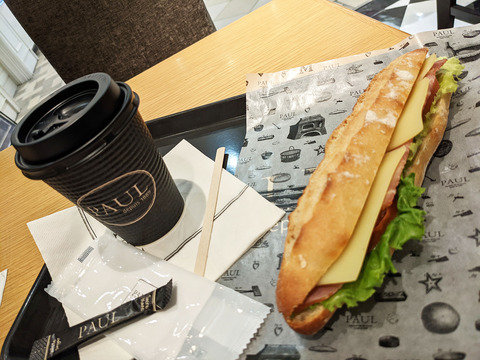夏から秋にかけての、梨。
夏には、幸水。
秋には、豊水。
それから、恵水。
豊水と恵水のあいだに、「あきづき」も出回ります。
今年は「あきづき」を食べました。
じゅわりと果汁があふれて、とても美味しかったです。
控えめな甘さが優しい感じで、後味がサッパリ。
なのに食後の満足感が、しっかりしていました。
『また食べたい』と思っているうちに、売り場はなくなっていて、次の品種に代わっていました。
ちなみに。
今年も「恵水」のタイミングを逸しました。
いまなら、新高。
今日、新高をいただきました。
ざりざりっとした繊維質な食感がして、梨は品種によって本当に違うなあと実感しています。
紅葉の時期になると、新興も出てきますね。
新興は年末年始の梨というイメージも強いです。
今年は、例年より意識して梨を食べている気がします。
毎日ではありませんが、旬のくだものとして。
I like fruit, but I often miss the right timing to eat them. Pears from summer to autumn. In summer, Kosui. In autumn, Hosui. Then, Keisui. Between Hosui and Keisui, Akizuki is also available. This year I tried Akizuki. Overflowing with juice, it was delicious. The subtle sweetness was gentle, and the aftertaste was refreshing. And yet, I felt very satisfied after eating. While I was thinking, "I want to eat it again," the sales area had disappeared and the next variety had been replaced. By the way. I missed the right timing to eat Keisui again this year. Right now, they have Shinko. I had Shinko today. It has a crunchy, fibrous texture, and I realize that pears really are different depending on the variety. When the leaves change color, Shinko also appears. Shinko is also strongly associated with the New Year's holiday pear. This year, I feel like I've been eating pears more than usual. Not every day, but as a seasonal fruit.
【参考記事】
茨城県は、千葉県に次いで全国第2位の梨生産地です。
秋梨フェア
【2024年9月加筆】
[Updated September 2024]
2024年の視点から見ると、梨の品種はさらに多様化し、楽しみ方も広がっています。
最近では、新しい品種の梨が次々と登場しています。例えば、「秋麗(しゅうれい)」や「甘太(かんた)」など、独自の風味や食感を持つ梨が注目されています。これにより、梨の楽しみ方が一層広がり、季節ごとに異なる品種を楽しむことができるようになりました。
また、梨の栽培技術も進化しています。農家の努力により、より美味しく、より栄養価の高い梨が生産されています。特に、無農薬や有機栽培の梨が注目されており、健康志向の高い消費者に支持されています。
さらに、梨を使った新しいレシピや加工品も増えています。例えば、梨を使ったスムージーやジャム、さらには梨を使ったスイーツなど、多岐にわたる商品が開発されています。これにより、梨の魅力がさらに広がり、多くの人々に愛されています。
また、梨をテーマにしたイベントも各地で開催されています。例えば、梨の収穫祭や試食会、さらには梨を使った料理教室など、多くの人々が梨の魅力を楽しむ機会が増えています。これにより、梨の知名度がさらに高まり、多くの人々に親しまれています。
さらに、梨の栄養価についても再評価されています。梨にはビタミンCや食物繊維が豊富に含まれており、美容や健康に良いとされています。特に、梨の果汁には抗酸化作用があり、免疫力を高める効果が期待されています。これにより、梨を食べることで健康を維持することができるとされています。
このように、2024年の視点から見ると、梨の品種はますます多様化し、その魅力が広がっています。これからも、梨の新しい楽しみ方を見つけて、日常生活に取り入れていきたいですね。
From the perspective of 2024, pear varieties have become even more diverse and the ways of enjoying them have expanded. Recently, new varieties of pears have appeared one after another. For example, pears with unique flavors and textures such as "Shuurei" and "Kanta" have attracted attention. This has further expanded the ways of enjoying pears, and it has become possible to enjoy different varieties in each season. Pear cultivation techniques are also evolving. Thanks to the efforts of farmers, pears that are tastier and more nutritious are being produced. In particular, pears grown without pesticides or organically are attracting attention and are supported by health-conscious consumers. In addition, new recipes and processed products using pears are also increasing. For example, a wide range of products have been developed, such as smoothies and jams using pears, and even sweets using pears. This has further expanded the appeal of pears, making them loved by many people. In addition, pear-themed events are also being held in various places. For example, there are more opportunities for many people to enjoy the charm of pears, such as pear harvest festivals, tasting events, and even cooking classes using pears. This has further increased the recognition of pears, and they are now familiar to many people. In addition, the nutritional value of pears is also being reevaluated. Pears are rich in vitamin C and dietary fiber, and are said to be good for beauty and health. In particular, pear juice has antioxidant properties and is expected to have the effect of boosting the immune system. As a result, it is said that eating pears can help maintain good health. In this way, from the perspective of 2024, pear varieties are becoming more and more diverse, and their appeal is spreading. I hope to continue to find new ways to enjoy pears and incorporate them into my daily life.
オリジナル投稿:2019年9月30日








